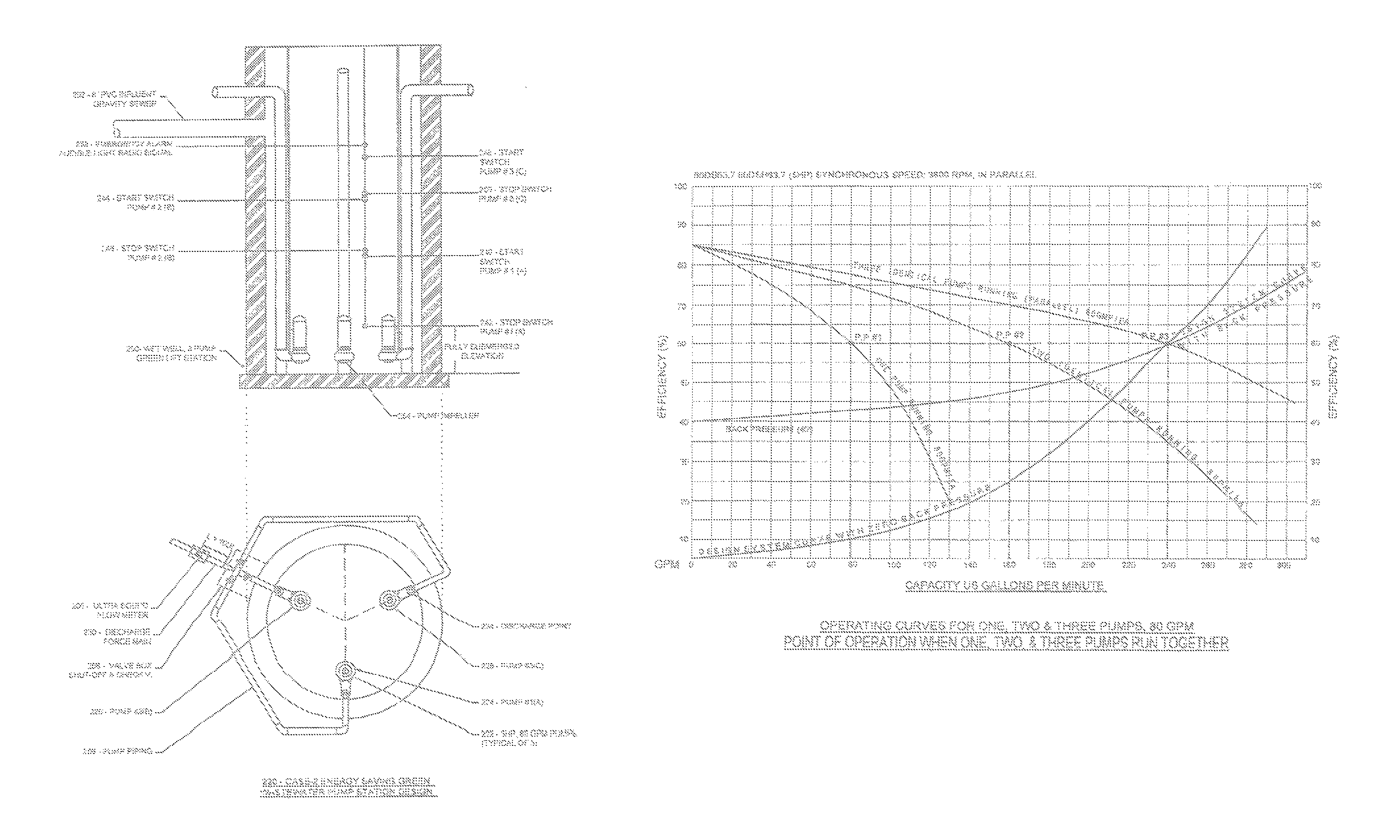Energy saving green wastewater pump station design
a technology of waste water pump station and green technology, applied in the direction of pump control, positive displacement liquid engine, pump, etc., can solve the problems of increased maintenance requirements of pumps operating under this design, inefficient design and maintenance, and loss of kinetic energy, so as to reduce the amount of energy, minimize the requirement of pump horse power, and reduce the effect of friction resistan
- Summary
- Abstract
- Description
- Claims
- Application Information
AI Technical Summary
Benefits of technology
Problems solved by technology
Method used
Image
Examples
case i
Traditional Waste Water Pump Station with Two Pumps 160 GPM, 60 ft Head Each Pump
[0054]The product of EBARA INTERNATIONAL CO. has been used in this study. For a pump station with two pumps 104 and 106, 160 GPM, a total head of 60 ft of water, the submersible pump 104 and 106 from the group of DSU of EBARA was selected as:
[0055]Model No. 80 DS63.7, 5HP, Synchronous Speed of 3600 RPM, 3″ Discharge, Solid Diameter ⅜″. The pump 104 and 106 performance curves are given in FIG. 6a and FIG. 6b.
[0056]In this graph, the point of operation is between two curves of impeller 126 mm and 114 mm. The impeller of 126 mm should be trimmed down to 308.5 mm.
Wet Well 102 Dimension & Storage Capacity—
[0057]Wet wells 102 usually are in the shape of a cylinder and are constructed from reinforced concrete. In addition to housing the pumps 104 and 106, the wet well's 102 function as a fluid storage container that regulates the discharge flow 134. The storage capacity of several wet wells 102 for one ft. of...
case-ii
Pump Station with Three Pumps 220
80 GPM, 60 ft Head Each Pump
[0064]In this design 220, the same in-flow profile for 24 hours of FIG. 1 was used. The pump station 220 has the following specifications:
1—The wet well 200 is a concrete cylinder of 8 feet diameter with a depth of 18 feet.
2—The lateral force main 126 is a 4 inch pipe and identical to the design of the two pump waste water pump station 112; therefor, the system curve is the same and the total head for the pump station will be 60 feet.
3—The design pump 224, 226 and 228 GPM, in contrary to the two pump system 112, is associated with the minimum in-flow rate which is almost 50% of the maximum in-flow. The flow rate of 80 GPM has been selected for the pumps 224, 226 and 228.
4—The pump station has three identical pumps 224, 226 and 228, each with 80 GPM and a total head of 60 feet of water.
5—In this design, the effort was to modify the traditional two pump station 112 to a more efficient one 220 for the purpose of analysis and ...
case ii
5—Numerical Values for Case I and Case II Pump Stations—
[0097]Discharge static head and suction static head for pump stations with the traditional two pump design (case 1) 112 and the Three Pump Energy Saving Green Pump Station Design (case II) 220 have been tabulated as (TABLE 3):
[0098]
TABLE 3PUMP#1PUMP#2PUMP#3CASE ITWO PUMP LIFT-STATIONOPERATING CONDITIONSONLY PUMP#1 RUNSBOTH PUMPS RUNDISCHARGE STATIC HEAD17.5 FEET17.5 FEETSUCTION STATIC HEAD−5.5 FEET−12.5 FEET FOR BOTHCASE IITHREE PUMP LIFT-STATIONOPERATING CONDITIONSONLY PUMP#1 RUNSBOTH PUMPS 1 AND 2 RUNALL THREE PUMPS RUNDISCHARGE STATIC HEAD 16 FEET 16 FEET16 FEETSUCTION STATIC HEAD−7.5 FEET−10.5 FEET FOR−13.5 FEET FORBOTH PUMPSALL THREE PUMPS
6—Actual Friction Loss—
[0099]Design friction loss is based on design GPM of the force main 300 / 302 at the maximum GPM. However, most of the time the actual flow rate is less than the maximum GPM. The actual friction loss can be calculated by the following equation:
DH=f×L / D×V2 / 2g ACTUAL ...
PUM
 Login to View More
Login to View More Abstract
Description
Claims
Application Information
 Login to View More
Login to View More - R&D
- Intellectual Property
- Life Sciences
- Materials
- Tech Scout
- Unparalleled Data Quality
- Higher Quality Content
- 60% Fewer Hallucinations
Browse by: Latest US Patents, China's latest patents, Technical Efficacy Thesaurus, Application Domain, Technology Topic, Popular Technical Reports.
© 2025 PatSnap. All rights reserved.Legal|Privacy policy|Modern Slavery Act Transparency Statement|Sitemap|About US| Contact US: help@patsnap.com



